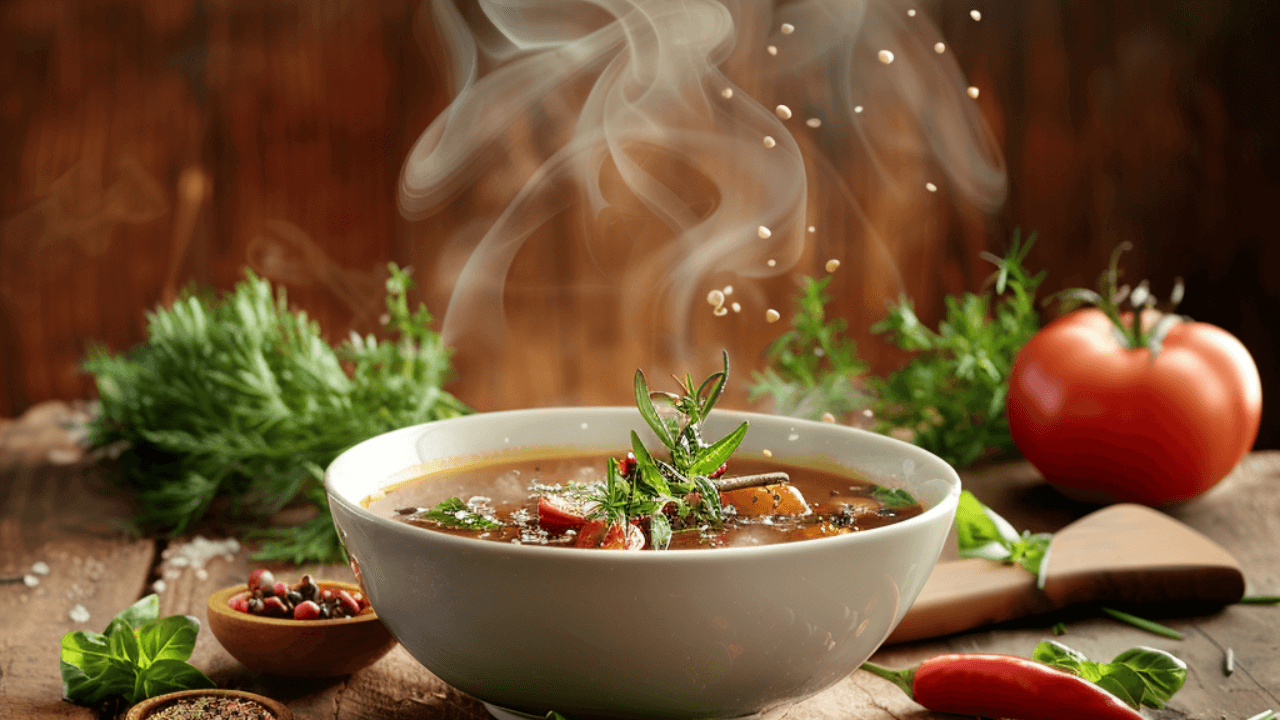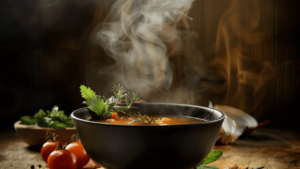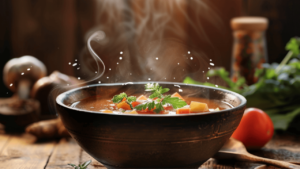What is the secret of the soup? Soup is a universal comfort food that spans cultures and generations, providing warmth, nourishment, and a sense of home. Whether it’s a hearty bowl of chicken soup on a cold day or a refreshing gazpacho in the summer, soups have a way of bringing people together. This article dives into the art and science of soup-making, uncovering the secrets that turn a good soup into a glorious one. From selecting the right ingredients to mastering cooking techniques, this guide will help you elevate your soup game.
What is the secret of the soup?
Hook: Ah, soup. There’s nothing quite like a steaming bowl of it to warm your soul and fill your belly. But what is it that makes some soups simply unforgettable while others fall flat?
Importance of Soup in Various Cultures: Soups have been a staple in kitchens around the world for centuries. From the French bouillabaisse to the Vietnamese pho, every culture has its own unique take on this versatile dish. It’s not just food; it’s a tradition, a comfort, and in many cases, a remedy.
Overview of What the Article Will Cover: In this article, we’ll explore the essentials of soup-making, uncovering the secrets that make a truly great soup. We’ll delve into the basic ingredients, discuss various techniques for enhancing flavor, and share tips from professional chefs. Whether you’re a novice cook or a seasoned chef, you’ll find valuable insights to help you create delicious, memorable soups.
Fundamentals of Soup Making
Basic Ingredients for Soup
The Role of Broth and Stock: The foundation of any good soup is a quality broth or stock. These liquid bases carry the essence of the ingredients they’re made from, whether it’s a rich, meaty stock or a light, vegetable broth. Using homemade broth can make a world of difference, infusing your soup with deep, authentic flavors.
Essential Vegetables and Aromatics: Vegetables like carrots, celery, and onions (often referred to as mirepoix) are essential for building a flavor base. Aromatics such as garlic, ginger, and herbs like thyme and bay leaves add complexity and depth. Don’t underestimate the power of these simple ingredients; they lay the groundwork for a delicious soup.
Choosing the Right Protein: Whether you’re making a hearty beef stew or a delicate chicken noodle soup, the protein you choose will significantly impact the flavor and texture. Opt for high-quality, fresh cuts of meat or seafood, and consider the cooking time required for each to ensure everything is perfectly tender.
Stay tuned for Part 2, where we’ll explore techniques for enhancing flavor and introduce some secret ingredients that can elevate your soups to the next level.
Fundamentals of Soup Making
Building Layers of Flavor
Caramelizing Vegetables: One of the first steps to intensifying flavor in your soup is to caramelize your vegetables. By slowly cooking onions, carrots, and celery until they’re golden brown, you develop a rich, sweet base that enhances the overall taste of the soup. The natural sugars in the vegetables break down, creating a depth of flavor that simply boiling won’t achieve.
Browning Meat: Just like caramelizing vegetables, browning meat adds a robust flavor to your soup. When you sear your meat before adding it to the pot, you lock in its juices and create a savory crust that enriches the broth. This technique is particularly effective for beef and chicken soups.
Adding Herbs and Spices: Fresh herbs and spices are the secret weapons of a flavorful soup. Add them at different stages of cooking to maximize their impact. For example, toss in hardy herbs like thyme and bay leaves early in the cooking process, while delicate herbs like parsley and cilantro should be added just before serving to preserve their vibrant flavors.
Secret Ingredients
Lemon Juice: A splash of lemon juice at the end of cooking can brighten up your soup, cutting through rich flavors and adding a fresh, zesty note. It’s a simple yet effective way to elevate your dish.
Fish Sauce: Just a few drops of fish sauce can add a savory umami depth to your soup, enhancing its overall complexity. It’s a secret ingredient in many Asian cuisines that works wonders in a variety of soups.
Worcestershire Sauce: This sauce brings a tangy, slightly sweet, and umami-rich flavor to your soups. It pairs well with tomato-based soups and stews, adding a layer of intrigue to the taste.
Sesame Oil: A drizzle of toasted sesame oil can add a nutty, aromatic element to your soup. It’s particularly delightful in Asian-inspired soups like miso or ramen.
Yogurt: Adding a dollop of yogurt can give your soup a creamy texture without the heaviness of cream. It also adds a subtle tanginess that can balance out the flavors, especially in spicy soups.
Incorporating these techniques and ingredients into your soup-making routine will not only improve the flavor but also add a professional touch to your homemade creations. Next, we’ll dive into special soup types and their unique secrets.
Special Soup Types and Their Secrets
-
Vegetable Soups
- Roasting Vegetables for Soup: Roasting intensifies vegetable flavors. It adds a smoky, caramelized depth. Toss veggies in olive oil. Season with salt and pepper. Roast until browned.
- Pureeing Techniques: Puree for smooth, creamy soups. Use an immersion or countertop blender. Puree in batches for consistency. Add broth or cream for texture.
-
Meat-Based Soups
- Slow Cooking Methods: Slow cooking extracts maximum flavor. Use a slow cooker or pot. Cook at low temperature. Flavors meld beautifully. Perfect for beef stew or chicken soup.
- Balancing Meat and Vegetables: Proportion meat and vegetables correctly. Equal parts meat and vegetables work best. Ensures hearty yet balanced soup. Mix of flavors and textures.
- Seafood Soups
- Selecting Fresh Seafood: Use the freshest seafood possible. Fresh fish, shrimp, and clams add delicate flavors. Check for fresh smell and clear eyes.
- Quick Cooking Techniques: Add seafood towards the end. Avoid overcooking. Quick cooking preserves delicate flavors. Ensures perfect texture.
These specialized techniques enhance different soup types. Tailor your approach to the ingredients. Next, we’ll discuss avoiding common soup-making mistakes.
Common Mistakes and How to Avoid Them
Avoiding Common Soup-Making Mistakes
Overcooking Ingredients: Overcooking vegetables can make them mushy, and overcooking meat can make it tough. To avoid this, cook vegetables until just tender and meat until it’s cooked through but still moist. Keep an eye on your pot and check the texture frequently.
Under-seasoning: Soup can often end up bland if not properly seasoned. Start with a moderate amount of salt and add more as needed. Don’t forget other seasonings like pepper, herbs, and spices. Taste your soup at various stages of cooking and adjust the seasoning accordingly.
Not Adjusting for Texture: The texture of your soup can significantly impact its enjoyment. For a creamy texture, blend a portion of the soup while leaving the rest chunky. This creates a nice balance of creamy and hearty textures. Additionally, consider adding ingredients like potatoes or beans to naturally thicken the soup.
Tips from Professional Chefs
- Chef Tips for Perfect Soup
- Use of Fresh Ingredients: Fresh ingredients make a significant difference in the flavor and quality of your soup. Fresh herbs, vegetables, and high-quality meats bring vibrant flavors and aromas. Always choose the freshest produce available, and avoid using wilted or expired ingredients.
- Importance of Tasting and Adjusting: Professional chefs constantly taste their dishes as they cook. This helps in adjusting the seasoning and ensuring the flavors are balanced. Don’t be afraid to tweak your soup by adding more herbs, spices, or even a splash of something acidic like lemon juice or vinegar to brighten the flavors.
- Presentation Tips: The presentation of your soup can enhance the dining experience. Garnishes like fresh herbs, a drizzle of olive oil, or a dollop of cream not only make the soup look more appealing but also add extra layers of flavor. Serve the soup in warm bowls to maintain its temperature longer, and consider using crusty bread as a side to complement the meal.
Frequently Asked Questions
FAQs about What is the secret of the soup?
-
- How do you fix a bland soup?: If your soup is bland, try adding a bit more salt or a splash of acid like lemon juice or vinegar. Fresh herbs can also brighten up the flavor.
- What can I add to soup for more flavor?: Add umami-rich ingredients like soy sauce, fish sauce, or a touch of Worcestershire sauce. Fresh herbs, spices, and a squeeze of citrus can also enhance the flavor.
- Can I make soup without a recipe?: Absolutely! Start with a good broth or stock, add your favorite vegetables and proteins, and season to taste. Experiment with different herbs and spices.
- How do you thicken soup naturally?: To thicken soup naturally, add starchy ingredients like potatoes or beans. You can also puree a portion of the soup and stir it back in for a thicker consistency.
- What is the best way to store homemade soup?: Store homemade soup in airtight containers in the refrigerator for up to four days. For longer storage, freeze the soup in portion-sized containers. Reheat gently to avoid overcooking.
These detailed tips and solutions from professional chefs and common soup-making questions will help you create soups that are both delicious and satisfying. Stay tuned for the conclusion, where we’ll recap the key points and encourage you to experiment with your soup recipes.
Recommended Internal Links
- Importance of Soup in Various Cultures
Exact Phrase: « From the French bouillabaisse to the Vietnamese pho, every culture has its own unique take on this versatile dish. »
Linking to the Busy Day Soup Recipe here provides a practical example of a quick and versatile soup that can fit into various cultural contexts.
- Overcooking Ingredients
World’s Best Soup: What Makes It So Special?
Exact Phrase: « Overcooking makes vegetables mushy and meat tough. Cook until just tender. »
Linking to the article about the No. 1 soup in the world here provides readers with an aspirational target and insight into how avoiding common mistakes can elevate their soup to a world-class level.
- Essential Vegetables and Aromatics
Creamy and Comforting Ultimate Potato Soup
Vegetables like carrots, celery, and onions (often referred to as mirepoix) are essential for building a flavor base.
External Links and Recommended Anchor Text
- The Kitchn – Secrets of Surprisingly Delicious Soups
- Recommended Anchor Text: « Secrets of Delicious Soups »
- Bon Appetit – 13 Ways to Make Better Soups
- Recommended Anchor Text: « Ways to Make Better Soups »
- Taste of Home – Grandma’s Best-Kept Soup Secrets
- Recommended Anchor Text: « Grandma’s Soup Secrets »
Conclusion
What is the secret of the soup? We’ve journeyed through the essential elements that make a great soup, from the importance of fresh ingredients and proper seasoning to the techniques that enhance flavor and texture. Understanding these fundamentals can transform your homemade soups into culinary delights.
Encouragement to Experiment with Soup Recipes: Don’t be afraid to experiment in the kitchen. Use the tips and secrets shared here as a foundation, but feel free to get creative. Try new ingredients, play with different textures, and adjust flavors to suit your palate. Remember, some of the best soups come from a willingness to explore and innovate.
Final Thoughts on the Art of Soup Making: Making soup is an art form that combines science, creativity, and a dash of love. It’s about more than just following a recipe; it’s about understanding how flavors interact and how to bring out the best in your ingredients. Whether you’re cooking for yourself, your family, or guests, a well-made soup is always a crowd-pleaser. So, embrace the process, enjoy the journey, and most importantly, savor the delicious results.
With this comprehensive guide, you’re well-equipped to make soups that are not only nourishing and comforting but also bursting with flavor. Happy cooking!



